If you spend time in Japan, you’ll notice groups coming together in outdoor parks to practice Radio Taiso in the morning or office workers practicing after lunch to aid in digestion.
“In Japan, everybody knows about Radio Taiso because we needed to do it every day in school,” says Kumiko Kanayama, Shiatsu Grandmaster and founder of The Five Lights Center of Shiatsu. “Beyond school, it’s broadcast on the public national TV station and radio. Many large companies organize their own Radio Taiso every day, so everyone exercises together at the office.”
For many in Japan, it’s not just about exercise, but also about coming together as a community.
“When I go back to Japan every summer, I go to the park each morning because there’s Radio Taiso,” Kanayama says. “I see people who are in their 80s or 90s exercising—and they’re strong and healthy because they leave the house, exercise, and meet people.”
That said, you don’t need to live in Japan or be a specific age to experience the benefits of Radio Taiso for yourself. Here’s how Radio Taiso originated, the benefits of the practice, and how to try it at home.
What is Radio Taiso, exactly?
The Japanese practice of Radio Taiso was originally inspired by morning exercises broadcast by the U.S. insurance firm Metropolitan Life, according to the Japan America Society of Houston. In November 1928, Japan launched the National Health Exercise Program (which was a precursor to Radio Taiso) to honor Emperor Hirohito’s formal ascension to the throne.
In 1951, it started being broadcast on public radio and has continued to air every day at 6:30 a.m. (and several more times throughout the day). In a 2003 survey, more than 27 million people said they took part in morning calisthenics more than two times per week, per the Japan America Society of Houston.
Since Radio Taiso launched, it has barely changed, though it was banned for a while after World War II due to its association with militarism, per The Guardian. Construction, factory, and office workers all partake in the practice—and in fact, the 10,000 employees of Tokyo’s metropolitan government are urged to practice it every weekday.
Although it’s so widely practiced throughout Japan, many in the United States are not familiar with it. Alessa Caridi, founder of JōbuFIT (a workplace wellness program modeled after Radio Taiso), attributes part of this to cultural differences between the East and the West.
“A few years back, I created a 12-minute movement routine that was very reminiscent of Japanese routines, but with more of a base in alignment and Pilates,” Caridi says. “When I started shopping it around 15 different offices in New York, they all loved the idea, but hated that they had to do the same thing every time.”
Repetition is a key part of Radio Taiso. While the practice is short, it incorporates iconic moves like raising your arms above your head and bringing them back down. Although Caridi has since shifted her offerings to fit more into a Western mindset, she notes that repetition is important for achieving excellence in many forms of exercise—from dance to Radio Taiso.
What are the benefits of Radio Taiso?
In the book Ikigai: The Japanese Secret to a Long and Happy Life, authors Héctor García and Francesc Miralles spoke to 100 of the oldest people in Okinawa, Japan. This island is considered a “blue zone” with the highest concentration of those ages 100 years and older in the world. Nearly all of them practiced Radio Taiso, even if it meant doing it from wheelchairs. (Radio Taiso can be done sitting or standing.)
Mobility exercises are helpful for the older adults because it helps to maintain functional independence.
“As flexibility and joint mobility tend to decrease with age, incorporating mobility exercises can help older adults maintain their independence by improving balance, reducing fall risk, and aiding in daily activities like bending, reaching, and walking,” says Kyle Krupa, DPT, CSCS, a physical therapist and founder of KRU PT + Performance Lab.
However, all ages can practice and benefit from mobility exercises like Radio Taiso. For instance, doing these exercises can help enhance performance and reduce injury in athletes, counteract the effects of prolonged sitting in office workers, and manage pain in those with chronic pain like arthritis.
Mobility, after all, doesn’t just refer to muscles. “It includes mobilizing joints and stretching the capsule surrounding the joint, to improve sliding and gliding motions of the joints themselves,” Krupa says.
In particular, Radio Taiso’s mobility exercises can help promote fluidity of motion and increase flexibility—with the added benefit of fostering a sense of community because it’s usually done in a group setting. It’s also very feasible for everyone, including those who might not have access to a gym.
“The majority of movements are conducted in extension and rotation, making it a great routine for addressing poor posture, limited spine range of motion, balance, and coordination,” Krupa says. “The progressions move from simple to more complex patterns that challenge the nervous system to increase joint awareness, also known as proprioception.”
Consistently practicing these full-range movements is what will help you maintain your mobility and flexibility over time.
“If you don’t use it, you’ll lose it, and one of the great things about mobility workouts and specifically Radio Taiso is that you’re extending your limbs all the way,” Caridi says. “It’s not just about a biceps curl, for instance—you practice really big swinging movements that we don’t do in our everyday lives anymore.”
Keep in mind that because Radio Taiso has a relatively low intensity and doesn’t vary much in difficulty, it may not be as helpful if you have very specific goals for strength, endurance, and flexibility. That said, many people in Japan practice Radio Taiso as a main form of exercise.
“Radio Taiso is the base of exercise in Japan and that’s how they can maintain their health and mind,” Kumiko says. “You could also do walking, bicycling, jogging, or swimming, but you don’t need to do much extra exercise.”
How to practice Radio Taiso yourself
Radio Taiso is made up of seven sitting movements designed to relax your mind and body—while also increasing flexibility, blood flow, and energy flow.
For each movement—demonstrated by Kylee McKay, assistant at The Five Lights Center of Shiatsu—don’t hold the stretch, but rather move rhythmically as you breathe in and out.
Here’s how to get started at home. (For a standing Radio Taiso routine you can also try this video from The Japan Society.)
Move 1
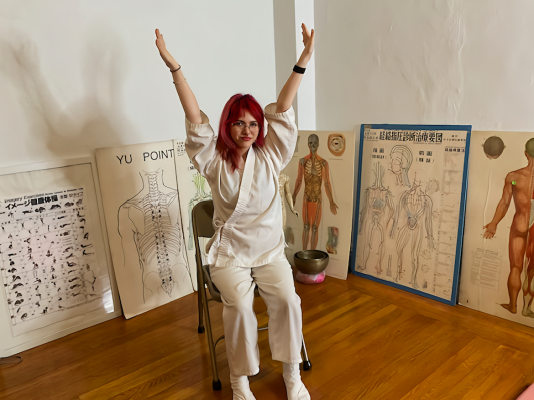
- Sit on a chair with your feet flat on the floor and your hands on your lap.
- Relax your legs and maintain a straight center.
- Stretch your arms up and then out, breathing deeply.
Move 2
This stretch helps strengthen the spine, increase flexibility, and boost muscle tone.
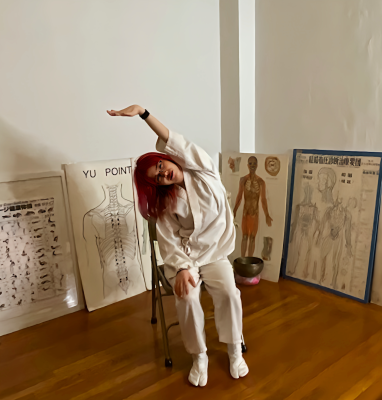
- Sit on a chair with your feet flat on the floor and your hands on your lap.
- Relax your legs and stretch left side of your body by lifting your left arm up and over to the right side with the palm facing up.
- Repeat on the other side.
Move 3
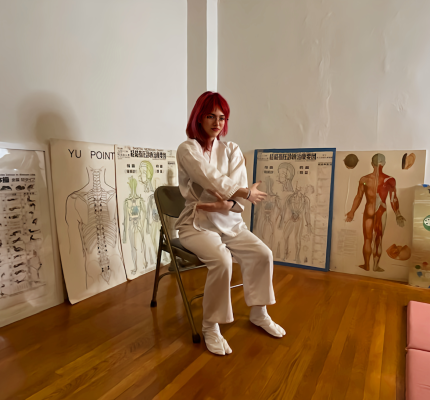
- Sit on a chair with your feet flat on the floor and your hands on your lap.
- Cross your arms in front of your body.
- Reach your fingertips to opposite sides of the room, breathing deeply.
Move 4
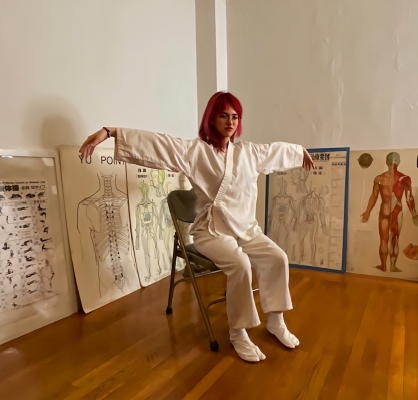
- From move 3 above (arms crossed in front of your body), open your arms to the side, keeping your wrists relaxed and palms facing down.
- Breathe deeply.
Repeat movements three and four together four times to help increase blood flow.
Move 5
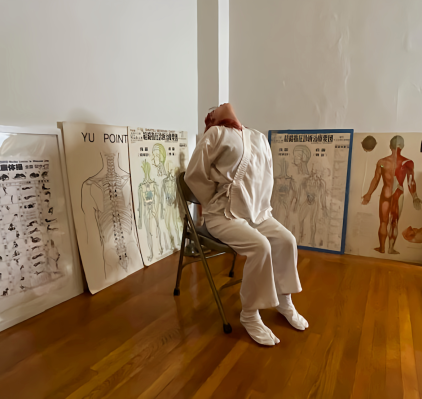
- Sit on a chair with your feet flat on the floor and your hands on your lap.
- Clasp your hands behind your back, open your chest, arch your back, and stretch your head backward.
- Breathe deeply.
Move 6
This movement releases shoulder and neck pain.
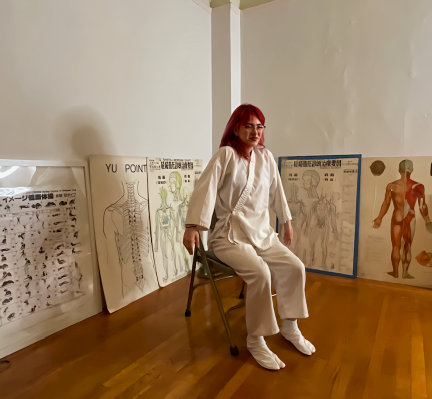
- Sit on a chair with your feet flat on the floor and your arms down by your sides.
- Raise your shoulders up toward your ears, then release.
Move 7
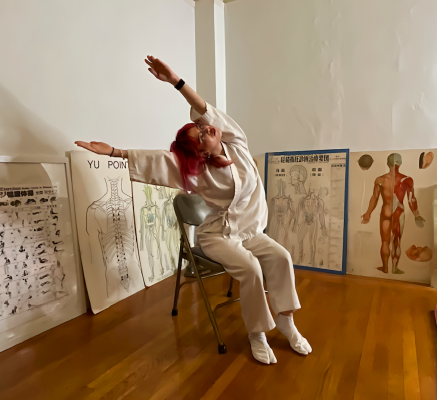
- Sit on a chair with your feet flat on the floor and your hands in your lap.
- With your legs relaxed, stretch both arms up and over to your right side with your palms facing each other.
- Repeat on the other side.
Our editors independently select these products. Making a purchase through our links may earn Well+Good a commission.
